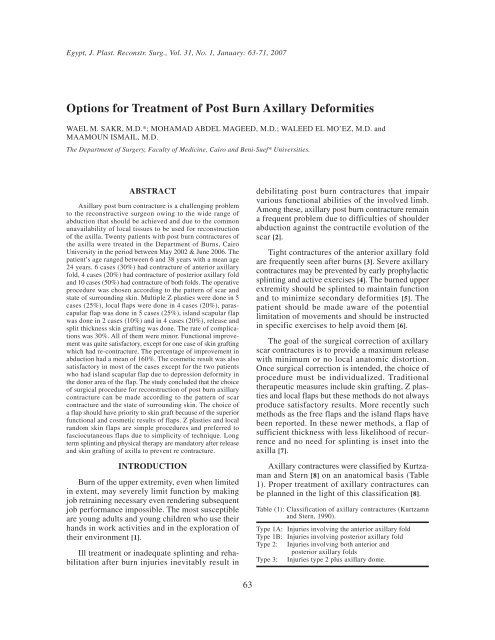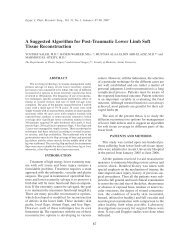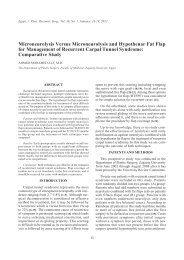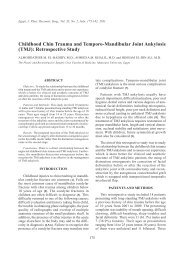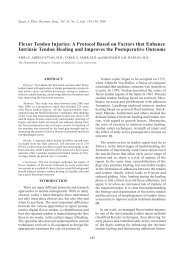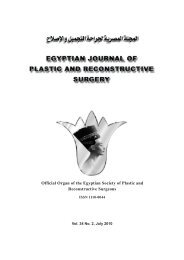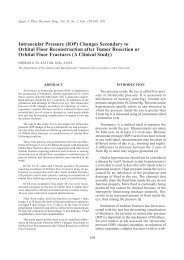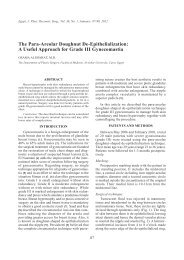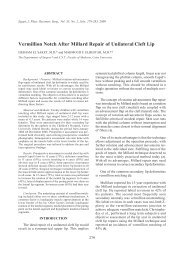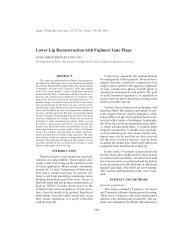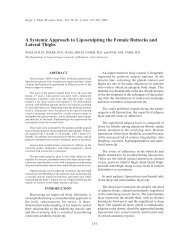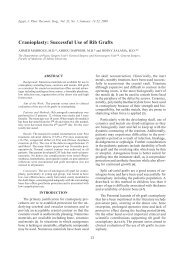Options for Treatment of Post Burn Axillary Deformities - ESPRS
Options for Treatment of Post Burn Axillary Deformities - ESPRS
Options for Treatment of Post Burn Axillary Deformities - ESPRS
You also want an ePaper? Increase the reach of your titles
YUMPU automatically turns print PDFs into web optimized ePapers that Google loves.
Egypt, J. Plast. Reconstr. Surg., Vol. 31, No. 1, January: 63-71, 2007<br />
<strong>Options</strong> <strong>for</strong> <strong>Treatment</strong> <strong>of</strong> <strong>Post</strong> <strong>Burn</strong> <strong>Axillary</strong> De<strong>for</strong>mities<br />
WAEL M. SAKR, M.D.*; MOHAMAD ABDEL MAGEED, M.D.; WALEED EL MO’EZ, M.D. and<br />
MAAMOUN ISMAIL, M.D.<br />
The Department <strong>of</strong> Surgery, Faculty <strong>of</strong> Medicine, Cairo and Beni-Suef* Universities.<br />
ABSTRACT<br />
<strong>Axillary</strong> post burn contracture is a challenging problem<br />
to the reconstructive surgeon owing to the wide range <strong>of</strong><br />
abduction that should be achieved and due to the common<br />
unavailability <strong>of</strong> local tissues to be used <strong>for</strong> reconstruction<br />
<strong>of</strong> the axilla. Twenty patients with post burn contractures <strong>of</strong><br />
the axilla were treated in the Department <strong>of</strong> <strong>Burn</strong>s, Cairo<br />
University in the period between May 2002 & June 2006. The<br />
patient’s age ranged between 6 and 38 years with a mean age<br />
24 years. 6 cases (30%) had contracture <strong>of</strong> anterior axillary<br />
fold, 4 cases (20%) had contracture <strong>of</strong> posterior axillary fold<br />
and 10 cases (50%) had contracture <strong>of</strong> both folds. The operative<br />
procedure was chosen according to the pattern <strong>of</strong> scar and<br />
state <strong>of</strong> surrounding skin. Multiple Z plasties were done in 5<br />
cases (25%), local flaps were done in 4 cases (20%), parascapular<br />
flap was done in 5 cases (25%), island scapular flap<br />
was done in 2 cases (10%) and in 4 cases (20%), release and<br />
split thickness skin grafting was done. The rate <strong>of</strong> complications<br />
was 30%. All <strong>of</strong> them were minor. Functional improvement<br />
was quite satisfactory, except <strong>for</strong> one case <strong>of</strong> skin grafting<br />
which had re-contracture. The percentage <strong>of</strong> improvement in<br />
abduction had a mean <strong>of</strong> 160%. The cosmetic result was also<br />
satisfactory in most <strong>of</strong> the cases except <strong>for</strong> the two patients<br />
who had island scapular flap due to depression de<strong>for</strong>mity in<br />
the donor area <strong>of</strong> the flap. The study concluded that the choice<br />
<strong>of</strong> surgical procedure <strong>for</strong> reconstruction <strong>of</strong> post burn axillary<br />
contracture can be made according to the pattern <strong>of</strong> scar<br />
contracture and the state <strong>of</strong> surrounding skin. The choice <strong>of</strong><br />
a flap should have priority to skin graft because <strong>of</strong> the superior<br />
functional and cosmetic results <strong>of</strong> flaps. Z plasties and local<br />
random skin flaps are simple procedures and preferred to<br />
fasciocutaneous flaps due to simplicity <strong>of</strong> technique. Long<br />
term splinting and physical therapy are mandatory after release<br />
and skin grafting <strong>of</strong> axilla to prevent re contracture.<br />
INTRODUCTION<br />
<strong>Burn</strong> <strong>of</strong> the upper extremity, even when limited<br />
in extent, may severely limit function by making<br />
job retraining necessary even rendering subsequent<br />
job per<strong>for</strong>mance impossible. The most susceptible<br />
are young adults and young children who use their<br />
hands in work activities and in the exploration <strong>of</strong><br />
their environment [1].<br />
Ill treatment or inadequate splinting and rehabilitation<br />
after burn injuries inevitably result in<br />
63<br />
debilitating post burn contractures that impair<br />
various functional abilities <strong>of</strong> the involved limb.<br />
Among these, axillary post burn contracture remain<br />
a frequent problem due to difficulties <strong>of</strong> shoulder<br />
abduction against the contractile evolution <strong>of</strong> the<br />
scar [2].<br />
Tight contractures <strong>of</strong> the anterior axillary fold<br />
are frequently seen after burns [3]. Severe axillary<br />
contractures may be prevented by early prophylactic<br />
splinting and active exercises [4]. The burned upper<br />
extremity should be splinted to maintain function<br />
and to minimize secondary de<strong>for</strong>mities [5]. The<br />
patient should be made aware <strong>of</strong> the potential<br />
limitation <strong>of</strong> movements and should be instructed<br />
in specific exercises to help avoid them [6].<br />
The goal <strong>of</strong> the surgical correction <strong>of</strong> axillary<br />
scar contractures is to provide a maximum release<br />
with minimum or no local anatomic distortion.<br />
Once surgical correction is intended, the choice <strong>of</strong><br />
procedure must be individualized. Traditional<br />
therapeutic measures include skin grafting, Z plasties<br />
and local flaps but these methods do not always<br />
produce satisfactory results. More recently such<br />
methods as the free flaps and the island flaps have<br />
been reported. In these newer methods, a flap <strong>of</strong><br />
sufficient thickness with less likelihood <strong>of</strong> recurrence<br />
and no need <strong>for</strong> splinting is inset into the<br />
axilla [7].<br />
<strong>Axillary</strong> contractures were classified by Kurtzaman<br />
and Stern [8] on an anatomical basis (Table<br />
1). Proper treatment <strong>of</strong> axillary contractures can<br />
be planned in the light <strong>of</strong> this classification [8].<br />
Table (1): Classification <strong>of</strong> axillary contractures (Kurtzamn<br />
and Stern, 1990).<br />
Type 1A:<br />
Type 1B:<br />
Type 2:<br />
Type 3:<br />
Injuries involving the anterior axillary fold<br />
Injuries involving posterior axillary fold<br />
Injuries involving both anterior and<br />
posterior axillary folds<br />
Injuries type 2 plus axillary dome.
64 Vol. 31, No. 1 / <strong>Options</strong> <strong>for</strong> <strong>Treatment</strong> <strong>of</strong> <strong>Post</strong> <strong>Burn</strong> <strong>Axillary</strong> De<strong>for</strong>mities<br />
PATIENTS AND METHODS<br />
The study was conducted in the Department <strong>of</strong><br />
<strong>Burn</strong>s, Cairo University Hospitals in the period<br />
between May 2002 & June 2006. Twenty patients<br />
with post burn de<strong>for</strong>mities <strong>of</strong> the axilla were treated.<br />
Preoperative assessment:<br />
The age <strong>of</strong> the patient and the onset <strong>of</strong> the<br />
condition were recorded. History was taken with<br />
special concern on the cause <strong>of</strong> the burn and the<br />
initial management in the acute phase. General<br />
examination was done to exclude any medical<br />
problem and looking <strong>for</strong> other burn de<strong>for</strong>mities.<br />
All the cases were examined locally <strong>for</strong>:<br />
Degree <strong>of</strong> contracture (=degree <strong>of</strong> limitation<br />
<strong>of</strong> abduction) whether mild (>90), moderate (30-<br />
90) or severe (
Egypt, J. Plast. Reconstr. Surg., January 2007 65<br />
axis centered on the transverse line determined<br />
by the horizontal cutaneous branch <strong>of</strong> the circumflex<br />
scapular vessels. These are the feeding<br />
vessels. They emerge from the depth at a point<br />
2cm lateral to the junction between the upper<br />
third and lower two thirds <strong>of</strong> the line joining<br />
the lateral aspect <strong>of</strong> the acromion and the lower<br />
margin <strong>of</strong> the scapula. They then run transversely<br />
on the back. Dimensions <strong>of</strong> the flap corresponded<br />
to the axillary defect.<br />
Dissection started medially and extended laterally.<br />
The pedicle was identified as emerging through<br />
the triangular space. After dissection <strong>of</strong> the vascular<br />
pedicle, the flap was then rotated as an island flap<br />
and inset in the defect. The donor site was closed<br />
by a split thickness skin graft if primary closure<br />
could not be achieved.<br />
<strong>Post</strong>operative broad spectrum antibiotic was<br />
given <strong>for</strong> all cases <strong>for</strong> one week. Long term splinting<br />
and physical therapy were the rule in cases<br />
treated by skin grafting. Follow up visits were<br />
done after 3 days, 1 week, 2 weeks, 1 month, 3<br />
months and 6 months to monitor the progress.<br />
<strong>Post</strong>operative photographs were taken on follow<br />
up visits.<br />
RESULTS<br />
Patient’s age ranged between 6 and 38 years<br />
with a mean age 24 years. Out <strong>of</strong> the twenty cases<br />
studied, the right axilla was involved in 6 cases<br />
(30%) and the left was involved in 14 cases (70%).<br />
The cause <strong>of</strong> burn was mostly direct flame burn<br />
(16 cases = 80%), and less commonly due to scald<br />
burn (4 cases = 20%). Duration since burn ranged<br />
between one year and four years with a mean <strong>of</strong><br />
18 months. All the cases gave history <strong>of</strong> no or<br />
minimal physiotherapy or splinting <strong>for</strong> their axilla.<br />
Types <strong>of</strong> contracture were type 1A in 6 cases (30%),<br />
type 1B in 4 cases (20%) and type 2 in 10 cases<br />
(50%). The degree <strong>of</strong> contracture ranged between<br />
mild and severe (Table 2). The degree <strong>of</strong> abduction<br />
ranged between 20º and 90º with a mean <strong>of</strong> 60º.<br />
According to the pattern <strong>of</strong> scar, and accordingly<br />
the choice <strong>of</strong> procedure, cases were distributed as<br />
shown in Table (3).<br />
The degree <strong>of</strong> abduction one month postoperatively<br />
ranged between 120º and 150º, with a mean<br />
<strong>of</strong> 130º. The degree did not change over the next<br />
6 months <strong>of</strong> postoperative follow up except in one<br />
case from the group who had release and skin<br />
grafting i.e. one case <strong>of</strong> re-contracture (5%). Still<br />
the range <strong>of</strong> abduction in this case was much better<br />
than that prior to operation.<br />
The percentage <strong>of</strong> improvement in abduction<br />
in the studied cases ranged from 110% to 260%<br />
with a mean percentage <strong>of</strong> change in abduction <strong>of</strong><br />
160%. The maximum degree <strong>of</strong> abduction after<br />
each kind <strong>of</strong> operation is illustrated in Table (4).<br />
As regards complications, there were two cases<br />
<strong>of</strong> tip necrosis <strong>of</strong> the Z plasties flaps, one case <strong>of</strong><br />
wound infection, two cases <strong>of</strong> marginal flap necrosis<br />
(<strong>of</strong> less than 1cm width) in the parascapular<br />
flaps used, one case <strong>of</strong> patchy skin graft non take<br />
(small areas). All the complications were mild and<br />
were managed by repeated dressing until healing<br />
occurred.<br />
All the cases were satisfied about the functional<br />
results <strong>of</strong> the procedures done. Patients who had<br />
island scapular flap were complaining <strong>of</strong> the ugly<br />
depression de<strong>for</strong>mity in the donor area <strong>of</strong> the flap.<br />
Figs. (1-4) show photographs <strong>of</strong> some <strong>of</strong> the<br />
studied cases.<br />
Table (2): Degree <strong>of</strong> limitation <strong>of</strong> abduction be<strong>for</strong>e treatment<br />
in the studied groups.<br />
Mild >90º<br />
Moderate 30º-90º<br />
Severe
66 Vol. 31, No. 1 / <strong>Options</strong> <strong>for</strong> <strong>Treatment</strong> <strong>of</strong> <strong>Post</strong> <strong>Burn</strong> <strong>Axillary</strong> De<strong>for</strong>mities<br />
(A) (B)<br />
(C) (D)<br />
Fig. (1): Z-Plasty.<br />
(A) (B)<br />
Fig. (2): Z-Plasty.
Egypt, J. Plast. Reconstr. Surg., January 2007 67<br />
(A) (B)<br />
(A)<br />
(C)<br />
Fig. (3): Parascapular flap.<br />
(A)<br />
Fig. (4): Local flap (V-Y).<br />
(B)<br />
(B)<br />
Fig. (5): Parascapular flap.<br />
(C)
68 Vol. 31, No. 1 / <strong>Options</strong> <strong>for</strong> <strong>Treatment</strong> <strong>of</strong> <strong>Post</strong> <strong>Burn</strong> <strong>Axillary</strong> De<strong>for</strong>mities<br />
Table (4): Range and maximum degree <strong>of</strong> abduction after<br />
each kind <strong>of</strong> procedure.<br />
Type <strong>of</strong> procedure Number<br />
<strong>of</strong> cases<br />
Multiple Z plasties<br />
Local skin flaps<br />
Parascapular flaps<br />
Scapular flaps<br />
Skin grafting<br />
5 cases<br />
4 cases<br />
5 cases<br />
2 cases<br />
4 cases<br />
Range <strong>of</strong><br />
maximum<br />
degree <strong>of</strong><br />
abduction<br />
1 month<br />
after surgery<br />
120º-140º<br />
120º-150º<br />
120º-150º<br />
140º-150º<br />
120º-130º<br />
DISCUSSION<br />
Mean<br />
maximum<br />
degree <strong>of</strong><br />
abduction<br />
1 month<br />
after surgery<br />
130º<br />
140º<br />
130º<br />
145º<br />
125º<br />
<strong>Burn</strong> around the axillary region frequently leads<br />
to axillary scar contracture, one <strong>of</strong> the most difficult<br />
problems to prevent in burn patient [9].<br />
<strong>Axillary</strong> post burn contractures remain a frequent<br />
problem after thermal burns involving the<br />
trunk and upper arm. Difficulties in rehabilitation<br />
<strong>of</strong> shoulder abduction during the initial period and<br />
the contractile evolution <strong>of</strong> the scar contribute to<br />
this problem [10].<br />
Intensive exercise program under physical therapist<br />
supervision combine to give the patient the<br />
best chance <strong>of</strong> surviving his injury with minimal<br />
loss <strong>of</strong> function. Such a program is not easy <strong>for</strong><br />
the patient who is experiencing severe pain or <strong>for</strong><br />
the therapist who must insist that he moves the<br />
extremity in spite <strong>of</strong> the pain, but serious impairment<br />
<strong>of</strong> function will most surely result if it is not<br />
done [11].<br />
This study included 20 cases <strong>of</strong> post burn axillary<br />
contractures. Age <strong>of</strong> patients ranged between<br />
6 and 38 years with a mean age 24 year. The cause<br />
<strong>of</strong> burn was mostly direct flame burn (80%) and<br />
less commonly scald burn (20%), the latter was<br />
mostly the cause in children cases involved in the<br />
study.<br />
Almost all the studied cases gave history <strong>of</strong> no<br />
or minimal physiotherapy and splinting <strong>of</strong> the<br />
axilla in the acute phase. Many authors stressed<br />
the importance <strong>of</strong> exercises and splinting in burns<br />
<strong>of</strong> the axilla to maintain function and to minimize<br />
secondary de<strong>for</strong>mities [4,5,6,11-15].<br />
In our studied cases, the right axilla was involved<br />
in 6 cases (30%) and the left was involved<br />
in 14 cases (70%). Types <strong>of</strong> contracture were type<br />
1A in 6 cases (30%), type 1B in 4 cases (20%) and<br />
type 2 in 10 cases (50%). The degree <strong>of</strong> contracture<br />
ranged between mild and severe. The degree <strong>of</strong><br />
abduction ranged between 20º and 90º with a mean<br />
<strong>of</strong> 60º.<br />
The cutaneous gliding capacity <strong>of</strong> the shoulder<br />
area skin is important. Full abduction stretches<br />
both anterior and posterior folds <strong>of</strong> the axilla, and<br />
there is upward movement <strong>of</strong> the skin covering<br />
the lateral aspect <strong>of</strong> the trunk. Treating axillary<br />
contractures should replace these gliding possibilities<br />
[10].<br />
Many techniques have been described <strong>for</strong> the<br />
release <strong>of</strong> contracted scar axilla. Skin grafting is<br />
the simplest reconstructive method but it has several<br />
disadvantages [16]. Free skin grafts are somewhat<br />
difficult to apply in the concave surface <strong>of</strong> the<br />
axilla, and after sometime can lead to secondary<br />
contracture [10].<br />
Z plasties or local flaps such as transposition<br />
or advancement flaps usually can be used in linear<br />
scar contractures at the axillary folds, but they are<br />
not effective in severe axillary contractures or<br />
scarred adjacent tissue [16]. Z plasty is generally<br />
the procedure <strong>of</strong> choice <strong>for</strong> linear scar contractures.<br />
However, a single Z plasty is not suitable in the<br />
axillary contractures, because it requires large skin<br />
flaps in a limited area with displacement <strong>of</strong> the<br />
hair bearing area [7].<br />
Local flaps alone or in combination with split<br />
thickness skin grafts are helpful in correction <strong>of</strong><br />
burn scar contractures. The specific design <strong>of</strong> the<br />
flap is dependent on the distribution and extent <strong>of</strong><br />
scar or the more specifically the availability <strong>of</strong><br />
normal uninvolved skin adjacent to it. The surgeon<br />
must avoid flaps containing a significant portion<br />
<strong>of</strong> scar tissue particularly at the base <strong>of</strong> the flap<br />
[17].<br />
Fasciocutaneous flaps from the back such as<br />
scapular and parascapular flaps have been used <strong>for</strong><br />
treatment <strong>of</strong> obliterated axilla. They have proved<br />
to be excellent <strong>for</strong> resurfacing large defects involving<br />
the axilla, and their donor sites can be closed<br />
primarily up to a 10cm flap width. However the<br />
normal skin and subcutaneous tissues are thicker<br />
in the back than in the axilla, whereas the adjacent<br />
burn tissues surrounding the contracted axilla are<br />
usually even thinner than the normal tissue because<br />
<strong>of</strong> the scar contracture. There<strong>for</strong>e when the<br />
cutaneous flaps from the back are used <strong>for</strong> axillary<br />
reconstruction, they may induce the need <strong>for</strong> secondary<br />
debulking procedures [18].
Egypt, J. Plast. Reconstr. Surg., January 2007 69<br />
The island scapular flap <strong>of</strong>fers satisfactory<br />
functional and aesthetic improvement with its<br />
remarkable dimensions and acceptable thickness<br />
<strong>for</strong> the axillary region <strong>for</strong> all types <strong>of</strong> contracture<br />
[2].<br />
In this study, the operative procedure was chosen<br />
according to the pattern <strong>of</strong> scar. In 5 cases<br />
(25%), the scar was linear contracture <strong>of</strong> anterior<br />
or posterior axillary fold with healthy surrounding<br />
skin. Multiple Z plasties were done <strong>for</strong> these cases.<br />
The functional improvement and the cosmetic<br />
result were both satisfactory to the patients and<br />
surgeon.<br />
The disadvantage <strong>of</strong> this procedure is that unless<br />
the scar is a discrete band, they will not provide<br />
the desired release without skin grafting [19]. Our<br />
study found this disadvantage <strong>of</strong> this technique<br />
which is the main reason <strong>for</strong> the limitation <strong>of</strong> its<br />
indications in contracted scar axilla.<br />
In 4 cases (20%), the contracture was a moderate<br />
localized scar with healthy surrounding skin. Local<br />
flaps were done <strong>for</strong> these cases. The flap design<br />
and donor site was determined by the shape and<br />
location <strong>of</strong> the scar. Transposition flaps from inner<br />
arm were used in two cases <strong>of</strong> localized contracture<br />
bands in the posterior axillary fold. Advancement<br />
flaps from the axilla were used in two cases <strong>of</strong><br />
contracture bands <strong>of</strong> the anterior axillary fold. The<br />
functional improvement and the cosmetic result<br />
were both satisfactory to both the patients and the<br />
surgeons.<br />
The local flap consisting <strong>of</strong> non scarred and<br />
pliable skin is necessary to minimize residual<br />
contractures and to abduct arm without difficulty.<br />
Local random flaps are able to cover limited skin<br />
defects <strong>of</strong> the axilla [17].<br />
In 11 cases (55%) <strong>of</strong> this study, the previous<br />
techniques were not feasible either because the<br />
adjacent skin was scarred, or because the contracture<br />
was severe. The choice <strong>of</strong> procedure in these<br />
cases relied on the state <strong>of</strong> the skin <strong>of</strong> the scapular<br />
and parascapular areas as well as the size <strong>of</strong> the<br />
defect. If the size <strong>of</strong> the defect was less than 8cm<br />
and the parascapular area is healthy, parascapular<br />
flap was done. If the size <strong>of</strong> the defect was more<br />
than 8cm, or if the parascapular area was scarred,<br />
island scapular flap was done provided that the<br />
area <strong>of</strong> the back was free <strong>of</strong> scars. If neither scapular<br />
nor parascapular flap could be done, generous<br />
release was made and the defect was covered by<br />
split thickness skin graft.<br />
In 5 <strong>of</strong> the studied cases (25%), parascapular<br />
flap was done. The functional improvement and<br />
the cosmetic result were satisfactory. The disadvantage<br />
<strong>of</strong> this technique is that it is limited to<br />
axillary defects less than 8cm [10]. We followed<br />
this rule in this study. Although bigger flaps can<br />
be taken from parascapular areas if preliminary<br />
tissue expansion is done.<br />
The advantages <strong>of</strong> the parascapular flap are<br />
that it is possible to close the donor site primarily<br />
and it is possible to construct the axillary cavity<br />
[20].<br />
In 2 <strong>of</strong> the studied cases, island scapular flap<br />
was done. The indication was a defect bigger than<br />
8cm width, although the parascapular area was<br />
intact. The technique used was that described by<br />
Teat & Bosse [10]. The donor site in both cases<br />
was closed by split thickness skin graft. Both cases<br />
had excellent postoperative improvement in abduction.<br />
However, they both complained <strong>of</strong> bulkiness<br />
<strong>of</strong> the flap in their axilla and they are conscious<br />
about the depression at the grafted donor site.<br />
These disadvantages were mentioned in literature<br />
[10,18].<br />
In 4 <strong>of</strong> the studied cases (20%), the condition<br />
was not feasible <strong>for</strong> any <strong>of</strong> the fasciocutaneous<br />
flaps due to scarring <strong>of</strong> the scapular and parascapular<br />
area. In these cases, release and split thickness<br />
skin grafting was done. <strong>Post</strong>operative splinting<br />
was done <strong>for</strong> at least three months in these grafted<br />
cases. Functional improvement was noticed postoperative<br />
but in 1 case re-contracture occurred,<br />
most probably because he did not maintain wearing<br />
the splint.<br />
Skin grafting is the simplest reconstructive<br />
method but it has several disadvantages. Frequently<br />
there is a patchy take <strong>of</strong> skin graft due to the<br />
anatomy <strong>of</strong> the defect, and the prolonged splinting<br />
in abduction and faithful postoperative physical<br />
therapy are always necessary to avoid additional<br />
contracture. Furthermore the cosmetic result after<br />
skin grafting is poor [16].<br />
The rate <strong>of</strong> complications in this study was<br />
30%; two cases <strong>of</strong> tip necrosis <strong>of</strong> the Z plasties<br />
flaps, one case <strong>of</strong> wound infection, two cases <strong>of</strong><br />
marginal flap necrosis (<strong>of</strong> less than 1cm width) in<br />
the parascapular flaps used, one case <strong>of</strong> patchy<br />
skin graft non take (small areas). All the complications<br />
were minor and were managed by repeated<br />
dressing until healing occurred.<br />
Apart <strong>for</strong>m the case <strong>of</strong> re-contracture after skin<br />
grafting, the overall functional improvement was
70 Vol. 31, No. 1 / <strong>Options</strong> <strong>for</strong> <strong>Treatment</strong> <strong>of</strong> <strong>Post</strong> <strong>Burn</strong> <strong>Axillary</strong> De<strong>for</strong>mities<br />
quite satisfactory. The percentage <strong>of</strong> improvement<br />
in abduction had a mean <strong>of</strong> 160%. The cosmetic<br />
result was also satisfactory in most <strong>of</strong> the cases<br />
except <strong>for</strong> the two patients who had island scapular<br />
flap who complained <strong>of</strong> the ugly depression de<strong>for</strong>mity<br />
in the donor area <strong>of</strong> the flap.<br />
Conclusion:<br />
The choice <strong>of</strong> surgical procedure <strong>for</strong> reconstruction<br />
<strong>of</strong> post burn axillary scar contracture can be<br />
made according to the pattern <strong>of</strong> scar contracture<br />
Linear contracture<br />
<strong>of</strong> anterior or posterior<br />
axillary fold with<br />
healthy adjacent skin<br />
Multiple<br />
Z plasties<br />
Algorithm <strong>for</strong> the choice <strong>of</strong> operative technique <strong>for</strong> reconstruction <strong>of</strong> contracted scar axilla<br />
Moderate localized<br />
band <strong>of</strong> anterior or<br />
posterior axillary<br />
fold with healthy<br />
adjacent skin<br />
Local transposition or<br />
advancement flaps<br />
REFERENCES<br />
<strong>Axillary</strong> contracture<br />
Parascapular flap<br />
1- Basil A., Pruitt B.A. and Colanel M.C.: Epidemiology<br />
and general considerations in burns <strong>of</strong> the upper limb.<br />
Fourth edition, W.B. Saunders, Philadelphia, p 5-8, 1979.<br />
2- Nisanci M., Ergin E.R., Selcuk I. & Mustafa S.: <strong>Treatment</strong><br />
modalities <strong>for</strong> post burn axillary contractures and the<br />
versatility <strong>of</strong> the scapular flap. <strong>Burn</strong>s, 28: 177-180, 2002.<br />
3- Buda J., Thytlmuscan T. and Clarke J.: Inner arm fasciocutaneous<br />
flap in axillary burn scar contractures. Plast.<br />
Reconstr. Surg., 573-629, 1984.<br />
4- Roger E., Salisbury R.E. and William F.: Physical therapy<br />
<strong>for</strong> burns <strong>of</strong> the upper extremity. In Salisbury R.E. and<br />
Pruitt B.A. (Eds.), <strong>Burn</strong>s <strong>of</strong> the upper extremity. W.B.<br />
Saunders, Philadelphia, p 140-146, 1976.<br />
5- H. Basha and M.H. Abdullah: Classifications <strong>of</strong> post burn<br />
axillary contracture: Reappraisal <strong>of</strong> its rationale. EJPRS,<br />
Vol. (23), No. (2) July, 105-207, 1999.<br />
and the state <strong>of</strong> surrounding skin. An algorithm is<br />
suggested. The choice <strong>of</strong> a flap should have priority<br />
to skin graft because the functional and cosmetic<br />
results <strong>of</strong> flaps whether skin flaps or fasciocutaneous<br />
flaps are superior to skin grafting in the axilla.<br />
Z plasties and local random skin flaps are simple<br />
procedures. Whenever feasible, they are always<br />
preferred to fasciocutaneous flaps due to simplicity<br />
<strong>of</strong> technique. Long term splinting and physical<br />
therapy are mandatory after release and skin grafting<br />
<strong>of</strong> axilla to prevent re contracture.<br />
Defect with<br />
8cm + healthy<br />
scapular area<br />
Release and<br />
skin grafting<br />
Defect any size +<br />
scarred parascapular<br />
and scapular areas<br />
6- Kadry M.: Recent fasciocutaneous flaps <strong>for</strong> repair <strong>of</strong> postburn<br />
neck axillary and elbow contractures. Annals <strong>of</strong><br />
MBC Vol. II, 1989.<br />
7- Higazi M., Mandour S. and Shalaby H.A.: <strong>Post</strong> burn<br />
contracture <strong>of</strong> the axilla: Evaluation <strong>of</strong> three methods <strong>of</strong><br />
treatment. Annals <strong>of</strong> MBC, Vol. 3, March, 1990.<br />
8- Kurtzman I.C. and Stern P.J.: Upper extremity burn<br />
contractures. Hand Clinics, 6 (2): 261, 1990.<br />
9- Hurst D.E. and Haeseker B.: Fasciocutaneous flap in<br />
axillary region. Br. J. Plast. Surg., 35: 430, 1982.<br />
10- Teat I. and Bosse J.P.: The use <strong>of</strong> scapular skin island<br />
flaps in the treatment <strong>of</strong> axillary post burn scar contractures.<br />
Br. J. Plast. Surg., 47: 108, 1994.<br />
11- Jaeger D.L.: Maintenance <strong>of</strong> function <strong>of</strong> the burned patient.<br />
Phys. Ther., 52: 627-637, 1972.<br />
12- Achauer B.M. and Eriksson E.M.: Thermal burns in plastic<br />
surgery: Indications, operations and outcomes, pp. 365-<br />
368, 2000.
Egypt, J. Plast. Reconstr. Surg., January 2007 71<br />
13- Abhyankar S.V.: The salute splint <strong>for</strong> axillary contractures.<br />
Br. J. Plast. Surg., 54: 213-215, 2001.<br />
14- Manigandan C., Ashish K. and Reboy E.C.: A multi<br />
purpose self adjustable aeroplane splinting <strong>of</strong> axillary<br />
burns. <strong>Burn</strong>s, 29: 276-279, 2003.<br />
15- Salisbury R.E.: Initial management <strong>of</strong> burn. Triage and<br />
out patient care. In: Salisbury R.E., Nancy M.N., Dingeldein<br />
G.P. (Eds.) Manual <strong>of</strong> burn therapeutics. Boston,<br />
Toronto. Little Brown and Company, 88-91, 1983.<br />
16- Kim D.Y. and Cho S.Y.: Correction <strong>of</strong> axillary burn scar<br />
contracture with the thoracodorsal per<strong>for</strong>ator based<br />
cutaneous island flap. Annal Plast. Surg., 44: 181, 2000.<br />
17- Siebert J.W. and Longaker M.T.: The inframammary<br />
extended circumflex scapular flap. Plast. Reconstr. Surg.,<br />
7: 99-70, 1997.<br />
18- Hallock G.G.: Tissue expansion techniques in burn reconstruction.<br />
Ann. Plast. Surg., 274, 1987.<br />
19- Ahmet K. and Huseyin G.: The axial bilobed flap <strong>for</strong> burn<br />
contractures <strong>of</strong> the axilla. <strong>Burn</strong>s, 26: 628-633, 2000.<br />
20- Yanai A., Nagata S., Hirabayashi S. and Nakamura N.:<br />
Inverted U parascapular flap <strong>for</strong> the treatment <strong>of</strong> axillary<br />
burn scar contracture. Plast. Reconstr. Surg., 76: 126,<br />
1985.


